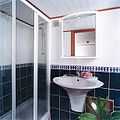Magna Carta (barge)
From Wikipedia, the free encyclopedia
 Magna Carta | |
| Career (England) | |
|---|---|
| Name: | Magna Carta |
| Route: | River Thames |
| Launched: | 1936 |
| Christened: | Pia |
| Status: | In service |
| General characteristics | |
| Class & type: | Commercial passenger vessel |
| Tonnage: | 225 |
| Length: | 117 ft (36 m) |
| Beam: | 16.5 ft (5.0 m) |
| Decks: | 2 |
| Installed power: | 230-volt 60KVA generator and inverters for silent night power |
| Propulsion: | Scania 218 HP |
| Speed: | Maximum 10 knots |
| Capacity: | 8 passengers |
| Crew: | 4 crew |
| Notes: | Holds 10 tons of water and 3 tons of fuel |
Magna Carta was built in the Netherlands in 1936. She was converted from a sand carrying cargo vessel to a hotel barge by Geoffrey K. Temple in 2001-2002 after 65 years of carrying cargo for the same family. She was sold to be replaced with a much larger vessel as she was no longer large enough to compete in the cargo carrying industry.[citation needed] She presently serves as a luxury hotel barge, cruising the River Thames.
Magna Carta currently has 4 double cabins allowing her to carry up to 8 passengers. She also has separate crew quarters which house the crew of four. Deck plan The crew consists of the captain, hostess, chef, and tour guide.[1][2][3]
References
- ↑ Steven B. Stern (2004). Stern's Guide to the Cruise Vacation 2005. Pelican Publishing Company. ISBN 978-1-58980-240-7.
- ↑ Kay Showker; Bob Sehlinger (2007). The Unofficial Guide to Cruises. Wiley. ISBN 978-0-470-08791-6.
- ↑ Shirley Slater; Harry Basch (1997). Fielding's Worldwide Cruises 1998. Fielding Worldwide. ISBN 978-1-56952-156-4.
External links
This article is issued from Wikipedia. The text is available under the Creative Commons Attribution/Share Alike; additional terms may apply for the media files.


